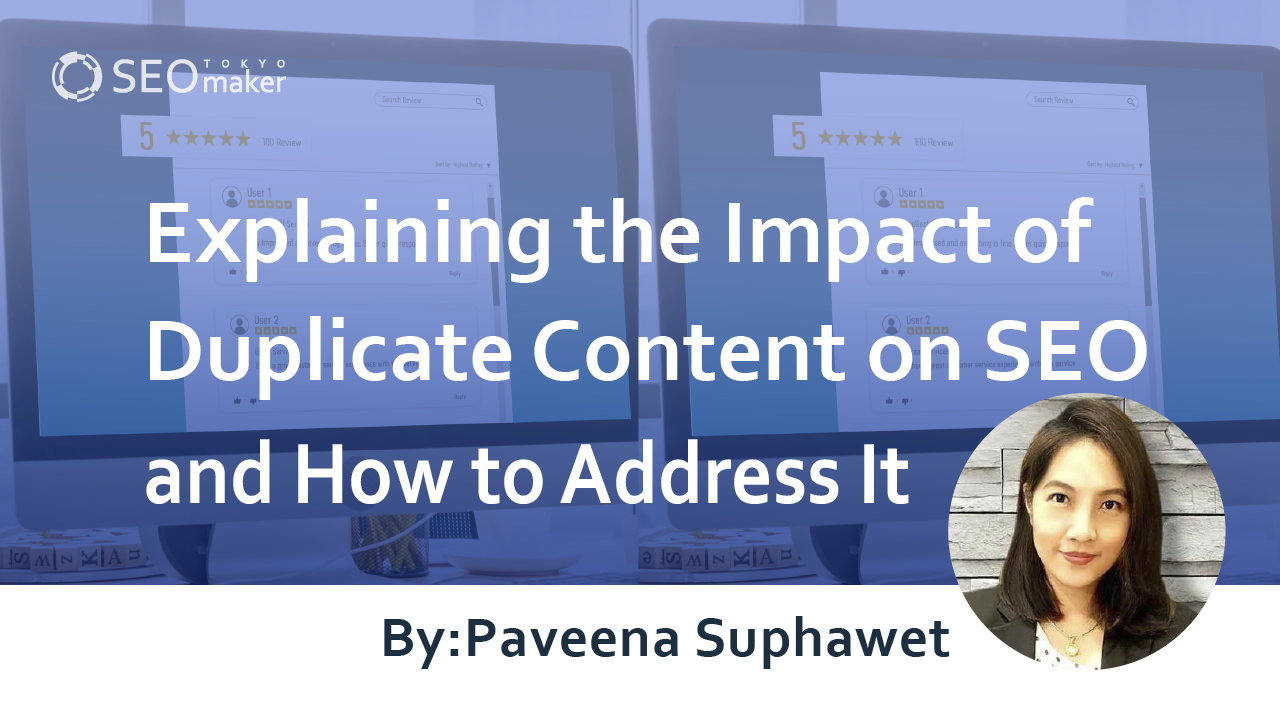Explaining the Impact of Duplicate Content (Duplicate URLs) on SEO and How to Address It
contents

Have you ever written content by referencing other content? If the content ends up being too similar, it can be considered duplicate content.
Duplicate content can lower your site’s rating from Google and have various impacts on your site. This article explains the effects of duplicate content on SEO and offers methods for dealing with it.
What is Duplicate Content?
Duplicate content refers to content that is exactly the same or very similar to other content. When creating content, it is common to reference other materials, which can sometimes lead to similarities.
However, content that is simply a modified version of something that already exists, or copying text and images directly, is considered duplicate content. Duplicate content is likely to be penalized by Google, so it’s important to regularly check if your content has unintentionally become duplicate.
Types of Duplicate Content
There are mainly two types of duplicate content.
POINT
-Internal duplication
-External duplication
Content is considered duplicate not only when it overlaps with external content from other sites, but also when it duplicates content within the same site.
Internal Duplication
This occurs within the same site. Even if you are not copying from another company but are replicating content within your own site, using similar text or images can be risky.
Common cases include pages that have multiple URLs due to the presence or absence of ‘www.’, automatically generated pages, or pages that use standard text. Such pages can inadvertently create duplicate content, so caution is needed.
External Duplication
Duplication with content from other sites can negatively affect SEO. Duplicate content can also be a compliance or copyright issue, potentially leading to copyright infringement.
Especially with external duplication, it’s important to understand the appropriate measures, not only when your content duplicates that of others but also when others replicate your content.
The Detriments of Duplicate Content on SEO
With the current algorithm prioritizing content quality, copying other content or intentionally increasing the number of pages to manipulate rankings can degrade the quality of your content. The negative impacts of duplicate content on SEO include the following.
POINT
-Lower Search Rankings
-Not Appearing in Search Results
-Dilution of Backlink Value
Here, we will explain the detrimental effects on SEO when penalized by Google for duplicate content.
Lower Search Rankings
When Google lowers its assessment of your site due to duplicate content, your search rankings can drop. Even if you were the first to create original content, if a more understandable and informative content is created later, Google may favor the latter as it provides more value.
Thus, even original content can be deemed as duplicate later and see a decline in rankings. Therefore, it is crucial to regularly review and update your content to ensure it remains fresh and relevant.
Not Appearing in Search Results
If Google identifies your content as duplicate, it may not appear in search results at all. Google’s crawlers assess the content of pages, and if similar content exists, only the content with the highest evaluation remains in the search results.
By not displaying multiple similar contents simultaneously in search results, Google enhances user experience. Therefore, content that is of low quality and duplicated often does not appear in search results.
Just as with declining search rankings, if your content does not appear in search results, it essentially becomes invisible to users.
The Impact of Backlink Evaluation Dispersion
When duplicate pages exist, the evaluation of backlinks can be dispersed. For instance, if a single page has an evaluation score of 100, the presence of duplicate content can split this score into 50 for each of the two pages.
The evaluation of a page significantly affects its search ranking. Therefore, if the evaluation is dispersed among similar contents, the original value of the page decreases. This can result in an incorrect evaluation from search engines and a drop in search rankings, necessitating proper management.
Google’s Evaluation of Duplicate Content
Google prioritizes user convenience. Therefore, it aims to display content that matches the keywords searched by users. Not only must the content meet user needs, but its originality and quality are also assessed.
Especially after the Panda update in 2011, content that is of low quality or does not provide value to users has been rigorously assessed.
Search engines’ algorithms for detecting duplicate content are continuously evolving. As a result, content that lacks originality and is of low quality is not rated favorably.
Methods to Check for Duplicate Content
There are mainly two methods to check for duplicate content.
POINT
-Searching on Search Engines
-Using Duplicate Content Check Tools
It’s important to understand these methods and regularly check for duplicate content.
Searching on Search Engines
One method is to perform checks using search engines. On Google Search, you can perform an exact match search for up to 32 characters.
To check specific text within your content, search using double quotation marks (“) around the text. If pages not belonging to your company appear at the top of the search results, it might indicate duplicate content.
Furthermore, searching within the content of pages that rank higher than your own can help identify any other duplicated content.
Using Duplicate Content Check Tools
The second method involves using duplicate content check tools. These tools help determine the similarity between your content and others, allowing for more accurate checks.
Unlike searching on search engines, these tools can analyze thousands of characters, making it easier to check entire contents quickly.
Additionally, these tools can automatically detect which parts of the content match, which is helpful during rewriting.
Recommended Duplicate Content Check Tools
When checking for duplicate content, using tools is advisable because they allow for quick and effective assessments. Here are four recommended tools for checking duplicate content.
Kagemusha
Kagemusha is a paid plagiarism check tool offered by CROCO Corporation. Although it is a paid tool, it can be used for free up to 10 times per month.
Using natural language processing technology, it can detect unauthorized copying and plagiarism of text on your website.
Given its accuracy, it is a highly recommended tool for effective content creation.
- Tool Name: Kagemusha
- URL: https://kagemusya.biz-samurai.com/
- Price: Free / Starting from 4,400 yen
Copy Content Detector
CopyContentDetector is a free plagiarism check tool operated by Web Circle Corporation. It allows you to diagnose up to 4,000 characters for free and is known for its quick and efficient checks.
Its unique algorithm can determine the similarity to the target web page and color-codes the duplicated parts, making the results easy to understand and the tool user-friendly.
- Tool Name: CopyContentDetector
- URL: https://ccd.cloud/
- Price: Free
Kopiran
Kopiran is a completely free tool that does not require registration. It allows checks for up to 4,000 characters and can identify plagiarism based on text, similarity count, and links.
One of Kopiran’s key features is the bookmarklet function, which allows you to check any text on a page simply by selecting a range.
- Tool Name: Kopiran
- URL: https://copyrun.net/
- Price: Free
Copypelner
Copypelner is a plagiarism detection software provided by AnK Corporation. Originally developed for supervising tests and papers, it has been implemented in over 610 schools, government offices, and corporations.
It is also useful for checking web page content, making it a valuable tool for duplicate content checks. Customizable for specific needs, it allows manual setting of pages and keywords for more accurate plagiarism checks.
- Tool Name: Copypelner
- URL: http://www.ank.co.jp/works/products/copypelna/Client/index.html
- Price: Starting from 6,660 yen
Handling Duplicate Content
If you find content that duplicates other content, it must be appropriately addressed. Understanding how to properly handle such situations is crucial.
POINT
- Deleting duplicate content
- Setting a 301 redirect
- Specifying a canonical tag
- Adding annotations
- Establishing original content
Here, we provide a detailed explanation of how to handle duplicate content.
Removing Duplicate Content
If your website contains redundant, unnecessary duplicate content, one solution is to delete one of the copies. If you prefer not to delete the content, you can use a meta element in the head tag with content=”noindex” to prevent the page from appearing in search results.
Additionally, if another site has copied content from your site, you will need to request the site operator to remove the content. If it’s challenging to get a response and your traffic is being affected, you can also file a complaint with search engines through Google Search Console.
Setting Up a 301 Redirect
A 301 redirect informs users and search engines that a page has been permanently moved to a new location. By setting up a 301 redirect, the user is automatically directed to the new page.
This is effective in cases where there are multiple URLs due to the presence or absence of “www.” or in cases with auto-generated pages, as mentioned in the examples of duplicate content within a site. If the affected pages have significant traffic or backlinks, it would be wasteful to simply delete them, making 301 redirects a beneficial solution.
Specifying Canonical Tags
The canonical tag, also known as the URL normalization tag, can specify the correct URL and consolidate duplicate URLs. This helps Google recognize the correct URL.
For example, it is useful in cases where different URLs are used to sell products in different colors or models, or when print-friendly content is provided. By writing the desired canonical URL within the <head> element of all potential duplicate pages, you can set the canonical tag.
If there is duplicate or similar content, setting the canonical tag and specifying the preferred URL for search engine prioritization is crucial.
Setting Annotations
Annotations notify search engines that the same content is displayed on separate pages for different devices. If you have separate URLs for smartphone and PC versions, setting annotations is recommended.
Set annotations on the PC page and canonical tags on the smartphone page. This prevents the dispersion of evaluation and focuses the assessment on the PC page.
Setting Up Original Content
If your content overlaps with that of others, adding original content can be effective. Including personal experiences, case studies, or third-party testimonials can differentiate your content.
While it is important to aim for originality when creating content, even original content can later become duplicate. Regularly checking and rewriting content to keep it updated and original is essential.
Instead of merely rephrasing or changing endings, it’s important to add weight to the content as original material.
Points to Avoid Content Duplication
To avoid content duplication, it’s important to include valuable information that only your company can provide, tailored to user needs. This will result in original content that is difficult for other companies to imitate.
While striving for originality, it’s also necessary to ensure the content is useful to users, rather than just focusing on what your company wants to convey.
Creating high-quality content that addresses user intent and is valued by both users and search engines is key to avoiding content duplication.
Summary
Duplicate content can lower your Google ranking and negatively impact SEO efforts. Unintentional duplication can happen, so it’s beneficial to use plagiarism check tools during content creation. Additionally, if your content is copied by others, take appropriate action to maintain your Google ranking. Focusing on user-first content and creating original content is essential.










![What is a Description? Explaining the Meaning, Writing Style, and Changing Word Count – [2023 Edition]](https://www.switchitmaker2.com/en/wp-content/uploads/2024/09/what-is-description.webp)










